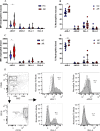Upregulated expression of Notch1/4 - JAG-1/DLL-1 detected in allergic rhinitis
- PMID: 37183251
- PMCID: PMC10183115
- DOI: 10.1186/s13223-023-00793-4
Upregulated expression of Notch1/4 - JAG-1/DLL-1 detected in allergic rhinitis
Abstract
Background: Allergic rhinitis (AR) is a chronic disease with high prevalence. There are currently many treatments available. However, despite an often good therapeutic response, many patients still report impairment in quality of life (QoL) during the pollen season. A skewed T helper (Th)2 polarization is a well-acknowledged pathologic feature of AR. In animal models, local notch signaling in peripheral tissue seems crucial for Th2 cell differentiation and the development of AR. However, the involvement of Notch signaling in Th2 cell differentiation and the development of AR in humans remains unknown. Hence, the present study investigated the human expression of Notch receptors on CD4+ T-cells in nasal mucosa and blood. Correspondingly Notch ligand expression was assessed on nasal epithelial cells and neutrophils.
Methodology: Nasal brush and blood samples from 18 patients with pollen-induced AR and 22 healthy controls were collected outside the pollen season. Notch 1-4 and Jagged-1,2 and Delta-like ligand 1,3-4 was analyzed using flow cytometry.
Results: The fraction of CD4+Notch1+ and CD4+Notch4+ T-cells was higher in AR patients than in healthy control patients. Further, the expression levels of the Notch ligands JAG-1 and DLL-1 were increased in nasal epithelial cells from AR patients compared to healthy control patients. In addition, AR patients displayed higher expression of JAG-1 on neutrophils both in the nasal mucosa and in peripheral blood.
Conclusion: The present study is the first to demonstrate increased activity in the Notch1/4 - JAG-1/DLL-1 pathways among allergic individuals. Further propagating the importance of Notch signalling in AR and blocking JAG-1 and DLL-1-induced Notch signalling by nasal epithelial cells and Neutrophils are potential targets to reduce allergic airway inflammation.
Keywords: Allergic rhinitis; Epithelial cells; Neutrophils; Notch; T-cells.
© 2023. The Author(s).
Conflict of interest statement
The authors declare no conflict of interest.
Figures



Similar articles
-
Notch Signaling Promotes Development of Allergic Rhinitis by Suppressing Foxp3 Expression and Treg Cell Differentiation.Int Arch Allergy Immunol. 2019;178(1):33-44. doi: 10.1159/000493328. Epub 2018 Nov 2. Int Arch Allergy Immunol. 2019. PMID: 30391960
-
NOTCH decoys that selectively block DLL/NOTCH or JAG/NOTCH disrupt angiogenesis by unique mechanisms to inhibit tumor growth.Cancer Discov. 2015 Feb;5(2):182-97. doi: 10.1158/2159-8290.CD-14-0650. Epub 2014 Nov 11. Cancer Discov. 2015. PMID: 25387766 Free PMC article.
-
Cancer-wide in silico analyses using differentially expressed genes demonstrate the functions and clinical relevance of JAG, DLL, and NOTCH.PLoS One. 2024 Jul 29;19(7):e0307943. doi: 10.1371/journal.pone.0307943. eCollection 2024. PLoS One. 2024. PMID: 39074091 Free PMC article.
-
[Expression and significance of Notch receptors in the mouse model of allergic rhinitis].Lin Chuang Er Bi Yan Hou Tou Jing Wai Ke Za Zhi. 2014 Oct;28(20):1585-9. Lin Chuang Er Bi Yan Hou Tou Jing Wai Ke Za Zhi. 2014. PMID: 25764759 Chinese.
-
Blocking Notch signalling reverses miR-155-mediated inflammation in allergic rhinitis.Int Immunopharmacol. 2023 Mar;116:109832. doi: 10.1016/j.intimp.2023.109832. Epub 2023 Feb 8. Int Immunopharmacol. 2023. PMID: 36764280
Cited by
-
Mechanisms of Neuronal Differentiation and Notch Signaling as a Potential Therapeutic Target in Olfactory Dysfunction of Allergic Rhinitis.J Inflamm Res. 2025 Apr 16;18:5097-5109. doi: 10.2147/JIR.S504050. eCollection 2025. J Inflamm Res. 2025. PMID: 40260448 Free PMC article.
References
-
- Bousquet J, Schunemann HJ, Togias A, Bachert C, Erhola M, Hellings PW, et al. Next-generation allergic rhinitis and its impact on Asthma (ARIA) guidelines for allergic rhinitis based on Grading of Recommendations Assessment, Development and evaluation (GRADE) and real-world evidence. J Allergy Clin Immunol. 2020;145(1):70–80e3. doi: 10.1016/j.jaci.2019.06.049. - DOI - PubMed
-
- Eriksson J, Ekerljung L, Pullerits T, Holmberg K, Ronmark E, Lotvall J, et al. Prevalence of chronic nasal symptoms in West Sweden: risk factors and relation to self-reported allergic rhinitis and lower respiratory symptoms. Int Arch Allergy Immunol. 2011;154(2):155–63. doi: 10.1159/000320230. - DOI - PubMed
LinkOut - more resources
Full Text Sources
Research Materials

